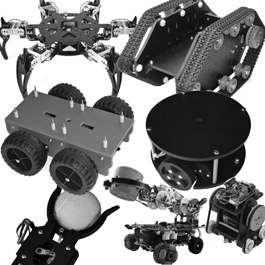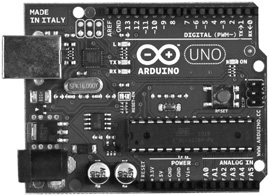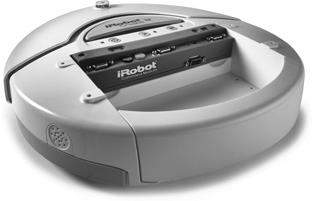Chapter 1
Welcome to the Wonderful World of Robotics!
There he sits, as he’s done countless long nights before, alone and deserted in a dank and musty basement. With each strike of his ball-peen hammer comes an ear-shattering bong and an echo that seems to ring forever. Slowly, his creation takes shape and form—it started as an unrecognizable blob of metal and plastic, soon it was transformed into an eerie silhouette, then …
Brilliant and talented, but perhaps a bit crazed, he is before his time: a social outcast, a misfit who belongs neither to science nor to fiction. He is the robot experimenter, and all he wants to do is make a mechanical creature that serves drinks at parties and wakes him up in the morning.
Okay, maybe this is a dark view of the present-day amateur robotics experimenter. Though you may find a dash of the melodramatic in it, the picture isn’t unrealistic. It’s a view held by many outsiders to the robot-building craft—a view more than 100 years old, from the time when the prospects of building a human-like machine first came within technology’s grasp.
Like it or not, if you want to build robots, you’re an oddball, an egghead, and—yes, let’s get it all out—a little on the weird side!
As a robot experimenter, you’re not unlike Victor Frankenstein, the old-world doctor from Mary Shelley’s immortal 1818 horror thriller. Instead of robbing graves in the still of night, you “rob” electronics stores, flea markets, and surplus outlets in your unrelenting quest—your thirst—for all kinds and sizes of motors, batteries, gears, wires, switches, and other gizmos. Like Dr. Frankenstein, you galvanize life from these “dead” parts.
What the Adventure Holds
Just starting out building your first robot? You’re in for a wonderful ride! Watching your creation do something as simple as scoot around the floor or table can be exhilarating. Those around you may not immediately share your excitement, but you know that you’ve built something—however humble—with your own hands and ingenuity.
Figure 1-1 Amateur robots can take many forms and sizes: mobile (moving) robots use wheels, tracks, or legs for propulsion; arms and grippers allow the robot to manipulate its environment. (Includes photos courtesy Lynxmotion and Russell Cameron)
If you’re one of the lucky few who has already assembled a working bot, then you know the excitement I’m talking about. You know how thrilling it is to see your robot obey your commands, as if it were a trusted dog.
You know the time and effort that went into constructing your mechanical marvel, maybe something like the ones in the robo-zoo picture in Figure 1-1—all are hobby robots. And although others may not always appreciate it (especially when it marks up the kitchen floor with its rubber tires), you’re satisfied with the accomplishment. You’re looking forward to the next challenge.
And if you’ve built a robot, you also know of the heartache and frustration that come with the process. You know that not every design works, and that even a simple engineering flaw can cost weeks of effort, not to mention ruined parts. This book will help you—beginner and experienced robot creator alike—get the most out of your robotics hobby.
Why Build Robots?
I wanted to build my first robot the moment I saw the sci-fi movie classic The Day the Earth Stood Still (the original, mind you, not the remake). Many have gotten the Bot Building Bug from watching movies, like Star Wars, Short Circuit, or Terminator.
No matter where the inspiration comes from, there are many reasons to build your own robot. Here are just a few of them.
ROBOTICS IS A KEYSTONE OF MODERN TECHNOLOGY
I recently purchased a new smartphone. As I went through its feature list I was amazed at all the things it could do—and how many of them were technologies we robot builders were playing with over a decade ago!
Robotics is a natural test bed for new ideas. Robot builders have been among the first amateurs to play with microcontrollers, accelerometers, digital compasses, voice control, electronic gyroscopes, global positioning satellite modules, speech synthesizers, solid-state imagers, vision recognition, tactile feedback, and many other cutting-edge technologies.
Figure 1-2 The modern microcontroller, like this Arduino, provides an amazing amount of computational power for controlling a robot.
What’s more, all of this is available at low cost. The pocket-size microcontroller circuit board in Figure 1-2 costs less than a dinner for two and rivals the thinking power of the computer that put Apollo astronauts on the moon. (You’ll be learning lots more about this microcontroller in Chapter 37, “Using the Arduino.”)
Whether you’re a garage-shop tinkerer, a student, or an engineer working for a Fortune 500 company, experimenting with amateur robotics gives you ample opportunity to discover the technologies the world will be using tomorrow.
ROBOTICS AS A GATEWAY TO A CAREER
Still going to school? Haven’t yet decided what you want to do with your life? Believe it or not, building a robot can lead the way.
Robotics involves dozens of interconnected sciences and disciplines—mechanical design and construction, computer programming, psychology, behavioral studies, ecology and the environment, biology, space, micro-miniaturization, underwater research, electronics, and much more.
You don’t need to be an expert in these fields just to build a robot. You can concentrate your studies on those things that most interest you, using your robot as a doorway to furthering your interests.
ROBOTICS TO THE RESCUE
Science fiction has long painted the robot as evil—either on its own or as the minion of a mad scientist. Yet it turns out robots may be a way for people to live better, longer lives.
![]() Robots can venture where people can’t, or don’t want to, go. Send a bot into a collapsed mine shaft, or to the bottom of the ocean, or to the dusty surface of Mars. It’ll get the job done, and it doesn’t need air or McDonald’s breaks.
Robots can venture where people can’t, or don’t want to, go. Send a bot into a collapsed mine shaft, or to the bottom of the ocean, or to the dusty surface of Mars. It’ll get the job done, and it doesn’t need air or McDonald’s breaks.
![]() A bomb-sniffing robot can save the lives of many people. It can locate the explosive and defuse it much more safely than humans can.
A bomb-sniffing robot can save the lives of many people. It can locate the explosive and defuse it much more safely than humans can.
![]() Robots can act as nurses and doctors, even to those with highly contagious diseases, halfway around the world.
Robots can act as nurses and doctors, even to those with highly contagious diseases, halfway around the world.
![]() Kids respond to robots in ways that can actually help them to develop interpersonal skills. There are even some robots used as therapy for children with certain learning and social disorders
Kids respond to robots in ways that can actually help them to develop interpersonal skills. There are even some robots used as therapy for children with certain learning and social disorders
MOST OF ALL, ROBOTICS IS FUN!
It’s okay to build robots just for kicks. Really!
Challenge yourself to a new project, and enjoy a hobby shared by many others worldwide. Share your designs on a blog or forum. Enter a competition to see whose robot is fastest or strongest. Post a video of your robot on YouTube, and show it off.
The Building-Block Approach
Robots are made of many individual parts that act as modules or subsystems. So a great way to learn about amateur-made robots is to construct individual components, then combine them to make a finished, fully functional machine.
The robots you create are made from building blocks, so making changes and updates to them is relatively simple. When designed and constructed properly, the building blocks, like those in Figure 1-3, may be shared among a variety of robots. To save time and money, it’s not unusual to reuse parts as you experiment with new robot designs.
Most of the building-block designs presented in this book are complete, working subsystems. Some operate without ever being attached to a robot or control computer. The way you connect the modules is up to you. You can experiment with each part, altering it and improving upon it. When it works the way you want, incorporate it into your robot or save it for a future project.
Lower Costs, Better Bots
Homebrew robotics used to be expensive and time consuming. Weak electronic brains limited what the finished robot could do. No longer. Amateur robots are now:
![]() Lower cost. It’s possible to build a fairly sophisticated autonomous robot for less than $75, with only ordinary tools. Similar robots used to cost $500 or $600 and required specialized gear to make.
Lower cost. It’s possible to build a fairly sophisticated autonomous robot for less than $75, with only ordinary tools. Similar robots used to cost $500 or $600 and required specialized gear to make.
![]() Simpler. Thanks to ready-made sensors, specialty electronics, and prefab parts, it’s much easier to construct robots by putting together construction blocks.
Simpler. Thanks to ready-made sensors, specialty electronics, and prefab parts, it’s much easier to construct robots by putting together construction blocks.
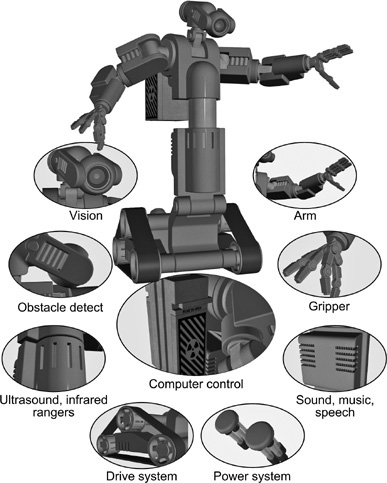
Figure 1-3 The basic building blocks of a fully functional robot include a computer control or other central processor, a drive system for mobility, and various sensors.
![]() More powerful. Inexpensive microcontrollers add horsepower and functionality, with more memory, faster processing speeds, and easier interfacing to other components. If you have a PC with a USB port, you can start working with microcontrollers today—many cost just a few dollars and can control an entire robot.
More powerful. Inexpensive microcontrollers add horsepower and functionality, with more memory, faster processing speeds, and easier interfacing to other components. If you have a PC with a USB port, you can start working with microcontrollers today—many cost just a few dollars and can control an entire robot.
Skills You Need
You don’t have to be an expert in electronics and mechanical design to build robots. Far from it. Which of these best describes you?
![]() I’m just starting out. If you’re an absolute raw beginner in all things robotics, start with the My First Robot lessons found on the RBB Online Support site (see Appendix A for details). The lessons give you step-by-step instructions for building the RBB Bot, an inexpensive autonomous (runs on its own) robot. You’ll learn about the fundamentals of electronics and robotics.
I’m just starting out. If you’re an absolute raw beginner in all things robotics, start with the My First Robot lessons found on the RBB Online Support site (see Appendix A for details). The lessons give you step-by-step instructions for building the RBB Bot, an inexpensive autonomous (runs on its own) robot. You’ll learn about the fundamentals of electronics and robotics.
![]() I have some electronics or mechanical background. Plow straight ahead to the construction guides and how-tos that follow. This book is organized into parts so that you can bone up on your skills and knowledge as you read.
I have some electronics or mechanical background. Plow straight ahead to the construction guides and how-tos that follow. This book is organized into parts so that you can bone up on your skills and knowledge as you read.
![]() I’m an experienced tinkerer. If you are already versed in electronics and mechanics, you’re well on your way to becoming a robot experimenter extraordinaire. You can read the chapters in the order you choose. There are plenty of cross-references among chapters to help you connect the dots.
I’m an experienced tinkerer. If you are already versed in electronics and mechanics, you’re well on your way to becoming a robot experimenter extraordinaire. You can read the chapters in the order you choose. There are plenty of cross-references among chapters to help you connect the dots.
ELECTRONICS BACKGROUND
Electronic circuits are what make your robots “thinking machines.” You don’t need extensive knowledge of electronics to enjoy creating robots. You can start with simple circuits with a minimum of parts. As your skills increase, you’ll be able to (at the least) customize existing circuits to match your needs.
This book doesn’t include much in the way of electronics theory, just practical information as it relates to building bots. If you’re looking for detailed college-level instruction on electronics, check out any local library and do a Web search for books and publications.
Many of the circuits in this book are in schematic diagram form, a kind of blueprint for how the parts of the circuit are connected. If you’ve never seen a schematic, you can read up on them in Part 5 of this book, plus the My First Robot lessons (see Appendix A, “RBB Online Support”), which includes a whirlwind introduction to electronics. There, you can see how a schematic road map corresponds to actual components of a circuit you can build yourself—see Figure 1-4 for an example. There are really only about a dozen common schematic symbols, and you can learn what you need to know with just an evening of study.
![]()
The parts for the electronic projects in this book are all selected to be widely available and reasonably affordable. I decided not to include vendor part numbers right in the book because these can change quickly.
Instead, you can visit the RBB Online Support site (see Appendix A) for updated lists of parts used in this book and where to get them. You’ll also find direct links to many parts—just click and you’re there.
Figure 1-4 Schematics are like road maps for building electronics. You only need to learn about a dozen common symbols, and you’re well on your way to building the typical robot circuit.
PROGRAMMING BACKGROUND
Modern robots use a computer or microcontroller to manage their actions. In this book you’ll find plenty of projects, plans, and solutions for connecting the hardware of your robot to any of several kinds of ready-made robot brains.
Like all computers, the ones for robot control need to be programmed. If you are new or relatively new to computers and programming, start with Chapter 36, “Programming Concepts: The Fundamentals.” None of the projects in this book require expensive or complex programming tools.
MECHANICAL BACKGROUND
Some robot builders are more comfortable with the mechanical side of robot building than the electronic or programming sides—they can see gears meshing and pulleys moving. As with electronics, you don’t need an extensive knowledge of mechanical and engineering theory to build robots.
This book provides several start-to-finish robot designs using a variety of materials, from cardboard to space-age plastic to aluminum. If you’re a workshop beginner, you’ll find helpful tips on what tools to use and the best materials for constructing your robot bodies.
If you’re one of those who just hate the idea of cutting a piece of wood, or drilling through plastic, there’s good news: you’ll find plenty of mail-order sources for purchasing bare-bones robot mechanics. You still need to assemble things, but you can get by with just a screwdriver. These sources are listed in Appendix B, as well as throughout the book and on the RBB Online Support site referenced in Appendix A.
THE WORKSHOP APTITUDE
To be a successful robot builder, you should be comfortable working with your hands. Even if you don’t build your own robot bodies start to finish, you’ll need to assemble the parts using basic tools.
If you feel your workshop skills aren’t up to par, try one of the basic robot platforms (bodies) in Part 2. You can choose a robot body made with wood, plastic, or metal.
You’ll find construction tips and techniques throughout this book, but nothing beats hands-on shop experience. With experience comes confidence, and with both come more professional results.
TWO VERY IMPORTANT SKILLS
So far, I’ve talked about basic skills that are desirable for the hobby robotics field. There two important skills that you cannot develop from reading books: they are patience and the willingness to learn.
![]() Be patient! Give yourself time to experiment with your projects. Don’t rush into things, or else you’re bound to make mistakes. If a problem continues to nag at you, put the project aside and let it sit for a few days. Keep a small notebook handy and jot down your ideas so you won’t forget them.
Be patient! Give yourself time to experiment with your projects. Don’t rush into things, or else you’re bound to make mistakes. If a problem continues to nag at you, put the project aside and let it sit for a few days. Keep a small notebook handy and jot down your ideas so you won’t forget them.
![]() Be willing to learn new things! If trouble persists, maybe you need to study more before you can tackle the problem. Be willing to go beyond this book and discover things on your own. Research is never in vain.
Be willing to learn new things! If trouble persists, maybe you need to study more before you can tackle the problem. Be willing to go beyond this book and discover things on your own. Research is never in vain.
Do It Yourself, Kits, or Ready-Made?
There’s never been a better time to be an amateur robot builder. Not only can you construct robots “from scratch,” you can buy any of several dozen robot kits and assemble them using a screwdriver and other common tools.
MAKE YOUR OWN
This book is chock full of robot projects made from wood, plastic, and metal. One of the robots you can build is shown in Figure 1-5. This one is the Hex3Bot, from Chapter 27, “Build Robots with Legs.” Construction takes about a day (depending on your shop skills) and requires only basic tools.
Or you can try building a robotic arm, complete with separate motors for each joint. See Chapter 28, “Experimenting with Robotic Arms,” for a project you can make in your shop. Then in Chapter 29, “Experiment with Robotic Grippers,” give your robo-arm a hand and fingers.
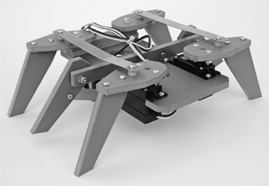
Figure 1-5 Using the right materials and tools, it takes a day or less to construct a homemade robot like this one. The Hex3Bot uses easy-to-cut plastic.
Figure 1-6 If the mechanics of robotics isn’t your forte, you can learn by using a ready-made robotic platform. This one is designed to teach the principles of robot programming. (Photo courtesy iRobot Corporation.)
READY-MADE BOTS
If you don’t particularly like the construction aspects of robotics, you can purchase ready-made robot bodies—no assembly required. With a ready-made robot you can spend all your time connecting sensors to it and figuring out new and better ways to program it. An example is the iRobot Create, shown in Figure 1-6. It’s like the iRobot’s Roomba vacuum-cleaning robot, but without the vacuum cleaner. It’s meant as a mobile robot platform for educators, students, and developers.
KIT O’ PARTS
You know the Erector set—this venerable construction toy provides the hardware for building all kinds of buildings, bridges, cars, and other mechanical things. The traditional Erector Set uses lightweight metal girders of different sizes, plus steel fasteners to put it all together.
Several specialty robotics companies have taken the Erector set one step further, modifying the idea to handle the unique issues of robot building. Their construction kits can be used to create fully functional robots, or you can adapt the bits and pieces to your custom designs. These aren’t exactly cheap, but they’re convenient and engineered to produce outstanding prototypes.
Here are four of the more popular parts kits specifically created for building robots.
VEX Robotics Design System
Aimed at both the educational and the hobbyist market, the VEX system is based around the Erector set style of predrilled girders and connector pieces. Most parts are fastened using traditional techniques of machine screws and nuts. What sets VEX apart is that its pieces are especially designed for small robotics. Kits come with motors made to fit the girder pieces, gears, wheels, and many other hardware parts.
Lynxmotion Servo Erector Set
The Servo Erector Set from Lynxmotion is composed of various brackets and other hardware for the express purpose of connecting together standard-size R/C servo motors. You can connect these brackets to a traditional robot base to build a rolling or walking machine or attach them to tubes, hubs, and connectors to fashion completely free-form designs.
Bioloid
The Bioloid robotic construction sets are engineered for serious robot building. Using a mixture of fabricated metal and plastic parts, Bioloid pieces can be combined to create both wheeled and walking bots, as well as fully functional grippers and arms. The sets include special high-torque digital motors plus a central microcontroller for operating all electronic components.
Pitsco/FIRST Robotics FTC Kit
FIRST (For Inspiration and Recognition of Science and Technology) is an organization cofounded by inventor Dean Kamen, of Segway fame, to develop ways to inspire young adults in the fields of engineering and technology. The organization hosts national competitions, such as the FIRST Tech Challenge (FTC), where teams of students are required to build, program, and demonstrate a robot that completes a certain task. The task changes for each year, to keep things interesting.
In order to provide a level playing field for all teams, FIRST limits robot construction to a preapproved kit of parts; the latest kit is assembled by educational equipment giant Pitsco. In the case of the FIRST Tech Challenge, the kit incorporates metal and other building parts.

If you like the parts that come with the latest FTC competition kits, you can purchase them separately without going through the FIRST organization. Visit www.pitsco.com, and do a search for TETRIX. Their channels and brackets are designed to interface with R/C and DC gear motors (see Figure 1-7) and can be used for all kinds of nifty projects.
PROJECTS TO MATCH YOUR SKILLS
Whether you choose to buy a robot in ready-made or kit form, or build your own from the ground up, be sure to match your skills to the project. This is especially true if you are just starting out. While you may seek the challenge of a complex project, if it’s beyond your present skills and knowledge level you’ll likely become frustrated and abandon robotics before you’ve given it a fair chance.
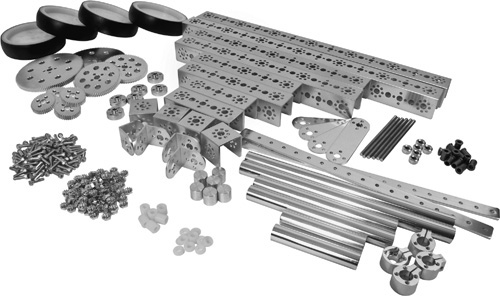
Figure 1-7 Some assembly required: precut and predrilled parts allow you to construct robots by piecing together metal or plastic components. (Photo courtesy Pitsco Education.)
Thinking Like a Robot Builder
Robot experimenters have a unique way of looking at things. They take nothing for granted:
![]() At a restaurant, it’s the robot experimenter who collects the carcasses of lobsters and crabs to learn how these ocean creatures use articulated joints, in which the muscles and tendons are inside the bone. Maybe the lobster leg can be duplicated in the design of a robotic arm …
At a restaurant, it’s the robot experimenter who collects the carcasses of lobsters and crabs to learn how these ocean creatures use articulated joints, in which the muscles and tendons are inside the bone. Maybe the lobster leg can be duplicated in the design of a robotic arm …
![]() At a county fair, it’s the robot experimenter who studies the way the “eggbeater” ride works, watching the various gears spin in perfect unison. Perhaps the gear train can be duplicated in an unusual robot locomotion system …
At a county fair, it’s the robot experimenter who studies the way the “eggbeater” ride works, watching the various gears spin in perfect unison. Perhaps the gear train can be duplicated in an unusual robot locomotion system …
![]() While flipping channels on the TV, it’s the robot experimenter who thinks that if the remote control can operate a television, the same technique can be applied to a robot …
While flipping channels on the TV, it’s the robot experimenter who thinks that if the remote control can operate a television, the same technique can be applied to a robot …
![]() When washing hands in a restaurant lavatory, it’s the robot experimenter who studies the automatic faucet control. The water is automatically turned on and off when the hands come near the sink. Could the same system be adapted to a robot, enabling it to judge distances and see things in front of it? …
When washing hands in a restaurant lavatory, it’s the robot experimenter who studies the automatic faucet control. The water is automatically turned on and off when the hands come near the sink. Could the same system be adapted to a robot, enabling it to judge distances and see things in front of it? …
The list is endless. All around us, from nature’s designs to the latest electronic gadgets, are infinite ways to make better and more sophisticated robots. Uncovering these solutions requires extrapolation—figuring out how to apply one design and make it work somewhere else.
And that’s what the robot builder is especially good at!

